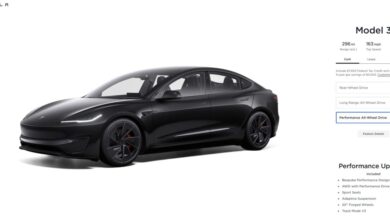How Riding an E-Bike for a Year Saved Me Money and Improved My Life

In early 2023, I was riding my e-bike across Grand Rapids, Michigan. It was below freezing and my eyes watered from the cold. Snow started to fall.
“It still beats driving,” I thought.
A few months earlier, my wife and I found ourselves suddenly without a car. (I crashed it. No one was hurt.) For a variety of reasons, we didn’t want to buy a new one. So we didn’t. Instead we turned to the much more manageable catalog of e-bikes and bought a couple.
Since we weren’t planning on going carless, I hadn’t set many expectations for our experiment. It held a lot of surprises, most of them good.
Here’s what I learned, what I miss most about a carless life and how — from my perspective — a bike (e- or otherwise) might make sense for you.
Why we could use more e-bikes
Transportation accounted for just under 30% of US greenhouse gas emissions in 2021, according to the Environmental Protection Agency, equivalent to about 180 million metric tons of carbon dioxide. It’s the biggest single source of greenhouse gas emissions in the country, and they nearly all come from burning fuel.
To avoid the worst effects of climate change, we need to stop burning fossil fuels — and fast. To do so will require action by nations, industries and major companies, but it doesn’t mean that individuals can’t take actions to ditch emissions in their personal lives.
Swapping your gas-powered car for an electric vehicle is one such action. Over their lifetimes, electric vehicles generate fewer carbon emissions than those powered by fossil fuels. But even when you add up biking-related emissions (e.g. making the bike, eating more food because you’ve exercised, riding two bikes instead of one car for two-person trips) trips by electric vehicles still release far more carbon than trips by bike. One study found that, in the city of Portland, Oregon, shifting 15% of the miles people travel to e-bike trips could save 1,000 metric tons of carbon dioxide emissions per day.
Even beyond the climate implications there are reasons to shift from cars to bikes. In 2022, more than 44,000 people died as a result of a car crash, according to provisional data from the US Centers for Disease Control and Prevention. After years of decline, the rate of driving-related fatalities is rising.
Why going full e-bike improved my life
Honestly, a not-insignificant part of our decision to buy e-bikes instead of another car was that buying a car felt harder. Still, once we had our bikes, the benefits were many and surprising.
E-bikes are fun
I’m not lying when I say I can’t remember a time I ran an errand, went to a restaurant or headed to a friend’s house on my e-bike and didn’t arrive in a better mood than I left. I definitely can’t say the same for trips in a car or, to a lesser extent, trips on my old Schwinn Continental. E-bikes recapture some of the joy I felt as a kid, when biking felt effortless and fast. The involuntary whoops let out by newbies who try out my bike support that theory.
Cars are more expensive
Before switching to e-bikes, my family drove a 2003 Acura TL. While I don’t remember the exact expenses, we figured that between insurance, registration, fuel and a couple hefty maintenance costs over the year or two previous, we spent about $300 each month on our car.
I admittedly didn’t track our bike expenses closely. In the first year since getting our e-bikes, we spent about $50 to get one flat fixed, close to $150 to replace the handlebars on one of the bikes and about $200 on saddlebags to transport library books and groceries. Alongside those one-time expenses, we pay for the electricity to keep them charged.
My bike’s battery size is 352 watt-hours. At the national average electric rate of 15.45 cents per kilowatt-hour, it should cost about 5.43 cents to charge fully. With the lowest level of assistance, the battery should last 53 miles, which means fuel costs me just a tenth of a penny per mile. If I didn’t want to pedal at all and just hold down the throttle, it would cost me a whopping half a penny per mile.
That’s still much cheaper than the electric vehicle we bought after a year. Our 2017 Chevy Bolt, which has a new 66 kilowatt-hour battery, costs about $10.19 to charge fully. With a range estimate of 256 miles (though that varies based on how fast and where you drive), it costs us about four cents per mile. A gas vehicle with a fuel efficiency of 30 miles per gallon using gasoline priced at $3.50 per gallon, costs a bit more than 11 cents per mile.
We also got a free six-month checkup from the shop we bought from. Routine maintenance would be an additional expense each year. No matter how you slice it, it’s still a savings of a couple hundred dollars a month and thousands each year.
If you account for purchase price (which cost around $2,000 each) the e-bikes still beat the car we eventually bought, even after we claimed the clean used vehicle tax credit.
Cars are dirty
Nothing drives this point home like stopping at a red light on your bike behind a car that idles. Exhaust, straight from the tailpipe to your lungs. Research has found that tailpipe emissions are responsible for thousands of premature deaths each year in the United States.
EVs do away with the tailpipe emissions, but are still going to kick up more dust and shed more tire particles than an e-bike.
Tips for reducing (or eliminating) your car use
Some people won’t be able to make every trip on an e-bike but, in my experience, it’ll work for more trips than you first think. Here are some ways to get out of the car and onto an e-bike that worked for a nervous person like me.
Get the right gear
If every grocery run I made saw me dangling produce from my handlebars, I would have quit in a week. If you’re going to be hauling things, get a bike that either has the cargo capacity you need or space to add it. A couple of panniers worked for me, but I don’t have kids to drive around.
The same goes for your clothing, especially if you’ll be riding in inclement weather. Stay safe with some high-visibility gear and a helmet, too.
Borrow a bike if you can
Before buying an e-bike, see if you can try out a friend’s. Before buying mine, riding a friend’s e-bike for a couple of weeks clarified how important fenders and cargo space were going to be.
Start small and learn
If you’ve only driven to get around, you likely won’t know what routes are best for biking. It took me some time to find the routes I enjoyed most and felt safest. With an e-bike it’s easy to opt for a slightly longer route that’s more pleasant. Shift your shortest trips to your e-bike first.
Track your vehicle related expenses
Money is a great motivator for me. Realizing that I was spending a few hundred dollars each month on an activity that I really hated helped me set it aside. CNET’s Liliana Hall found she could save $4,000 by swapping her car for a moped.
Look for deals, too. My savings would have been greater if I had muddled through a couple more weeks and shopped a Black Friday sale.
Don’t forget car rentals
With the money we saved ditching our car, we still could rent a car for longer trips or take an Uber or Lyft and still come out ahead for the month. We also happily paid our friends for the occasional use of their vehicles. Just because you’ve ditched your car doesn’t mean you’ll never drive again. You’ll just do it less, and probably be happier for it.



